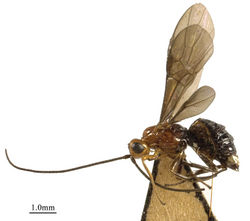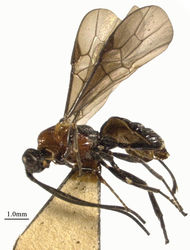Cyanopterus
| Notice: | This page is derived from the original publication listed below, whose author(s) should always be credited. Further contributors may edit and improve the content of this page and, consequently, need to be credited as well (see page history). Any assessment of factual correctness requires a careful review of the original article as well as of subsequent contributions.
If you are uncertain whether your planned contribution is correct or not, we suggest that you use the associated discussion page instead of editing the page directly. This page should be cited as follows (rationale):
Citation formats to copy and paste
BibTeX: @article{Li2020ZooKeys1038, RIS/ Endnote: TY - JOUR Wikipedia/ Citizendium: <ref name="Li2020ZooKeys1038">{{Citation See also the citation download page at the journal. |
Ordo: Hymenoptera
Familia: Braconidae
Name
Cyanopterus Haliday, 1835 – Wikispecies link – Pensoft Profile
- Cyanopterus Haliday, 1835: 22; Szépligeti 1904[1]: 21; Telenga 1936[2]: 343; Watanabe 1937[3]: 21; Tobias 1971[4]: 210; Shenefelt 1978[5]: 1676; Marsh 1979[6]: 170; Quicke 1987[7]: 109. Type species: Ichneumon flavator Fabricius, 1793 (Monobasic).
- Ipobracon Thomson, 1892: 1787 (as subgroup of Bracon Fabricius, 1804); Shenefelt 1978[5]: 1808; Quicke 1987[7]: 109. Type species: Bracon nigrator Zetterstedt, 1838 (Original designation). Synonymised by Quicke 1985[8]: 46.
- Bracambus Thomson, 1892: 1787 (as subgroup of Bracon Fabricius, 1804); Shenefelt 1978[5]: 1676; Quicke 1987[7]: 109. Type species: Vipio longipalpis Thomson, 1892 (Monobasic and Original designation) (= Ichneumon flavator Fabricius, 1804). Synonymised by Szépligeti 1904[1]: 21.
- Bracomorpha Papp, 1971: 276; Quicke 1985[8]: 358, 1987[7]: 104. Type species: Bracomorpha torkai Papp, 1971 (Monobasic). Syn. nov.
- Cyanopteridea Viereck, 1911: 476; Shenefelt 1978[5]: 1677; Quicke 1987[7]: 109. Type species: Iphiaulax clypeolus Szépligeti, 1905 (Original designation). Synonymised by Watanabe 1937[3]: 21.
- Coeloidimorpha Viereck, 1913: 558; Shenefelt 1978[5]: 1677; Quicke 1987[7]: 109. Type species: Bracon (Melanobracon) webbi Viereck, 1909 (Original designation) (= Bracon laevis Provancher, 1880). Synonymised by Muesebeck and Walkley 1951[9]: 159.
- Atanycolimorpha Viereck, 1913: 557; Shenefelt 1978[5]: 1436; Quicke 1987[7]: 109. Type species: Atanycolimorpha winnemanae Viereck, 1913 (Original designation) (= Bracon provancheri Dalla Torre, 1898). Synonymised by Quicke 1987[7]: 109.
- Notaulobracon Fahringer, 1929: 237; Shenefelt 1978[5]: 1809. Type species: Bracon nigrator Zetterstedt, 1838 (Original designation). Synonymised by van Achterberg 1997[10]: 30.
Diagnosis
Body medium-sized; terminal antennomere often strongly acute apically; in lateral view scapus without double margin at inner side apically and concave apico-laterally, ventrally longer than dorsally; eye glabrous, weakly emarginated; face smooth or superficially granulate, sometimes with a few sparse punctures; clypeus moderately narrow, often flattened and without dorsal carina; malar suture moderately developed, often with long and dense setae; labio-maxillary complex normal, not elongate; frons weakly depressed, with some setae and a median groove; mesosoma largely smooth and shiny; notauli present only anteriorly; scutellar sulcus narrow and crenulate; propodeum largely smooth, without medio-longitudinal carina or groove; angle between veins 1-SR and C+SC+R of fore wing more than 75°; fore wing vein 1-SR+M straight or slightly curved subbasally; fore wing vein cu-a interstitial or slightly postfurcal; hind wing vein SC+R1 longer than vein 1r-m; basal lobes of claws largely rounded; metasoma often largely smooth and shiny; length of T I less than 1.5× its apical width; T II usually with a large medio-basal area, and with oblique lateral grooves connected to wide sublateral grooves; antero-lateral grooves of T III often wide and short; T III–V with or without antero-lateral areas; ovipositor with dorsal nodus and ventral serrations subapically.
Biology
Most species are larval ectoparasitoids of Coleoptera (especially Cerambycidae and Curculionidae, but also some species of Buprestidae and Bostrichidae), and of Lepidoptera (mainly Sesiidae, Pyralidae, Erebidae, and Tortricidae) (Webb 1909[11]; Viereck 1912[12]; Fahringer 1926, 1934[13]; Ramakrishna Ayyar 1928[14]; Myers 1932[15]; Watanabe 1937[3]; Györfi 1941[16]; Grobler 1957[17]; De Santis and Esquivel 1966[18]; Fulmek 1968[19]; Papp 1971[20]; Tobias 1971[4], 1976[21], 1986[22]; Uhthoff-Kaufmann 1990[23]; Campadelli and Scaramozzino 1994[24]; Cordo et al. 1995[25]; Papp 2009[26]; Wang et al. 2009[27]; Yu et al. 2016[28]).
Distribution
Cosmopolitan.
Note
Tobias and Belokobylskij (2000)[29] divided this genus into three subgenera: Cyanopterus Haliday, 1835, Ipobracon Thomson, 1892, and Paravipio Papp, 1967; in this paper we include Bracomorpha Papp, 1971, as a subgenus; in China we have not yet found Ipobracon and Cyanopterus s. s.; and Paravipio is new to China. Bracomorpha may be easily confused with Acampyloneurus van Achterberg, 1992, but the latter has the lower ovipositor valve without teeth and the upper valve without nodus, T II with slightly converging sublateral depressions and the dorsal carina of the clypeus present. In addition, the type species has the first subdiscal cell of the fore wing distinctly (ca. 1.5×) higher than length of vein m-cu and scapus without apical ledge at inner side. In Bracomorpha the lower ovipositor valve has minute apical teeth and the upper valve has a minute nodus, the dorsal carina of the clypeus absent, T II with nearly parallel sublateral depressions or depressions largely absent, the first subdiscal cell is narrower than length of vein m-cu or subequal and scapus with more or less developed narrow apical ledge at inner side.
Taxon Treatment
- Li, Y; Achterberg, C; Chen, X; 2020: A new genus and eight newly recorded genera of Braconinae Nees (Hymenoptera, Braconidae) from China, with descriptions of fourteen new species ZooKeys, 1038: 105-178. doi
Images
|
Other References
- ↑ 1.0 1.1 Szépligeti G (1904) Hymenoptera. Fam. Braconidae.Genera Insectorum22: 1–253.
- ↑ Telenga N (1936) Insects Hymenoptera 5 (2). Braconidae, Pt. 1. In: Sernov SA, Stackelberg AA (Eds) Faune de l’URSS.l’Academie des Sciences de l’URSS, Leningrad, 402 pp. [in Russian; German text: 306–402]
- ↑ 3.0 3.1 3.2 Watanabe C (1937) A contribution to the knowledge of the Braconid fauna of the Empire of Japan. Journal of the Faculty of Agriculture, Hokkaido (Imp.) University42: 1–188.
- ↑ 4.0 4.1 Tobias V (1971) Review of the Braconidae (Hymenoptera) of the U.S.S.R.Trudy Vsesoyuznogo Entomologicheskogo Obshchestva54: 156–268. [Translation (1975). Amerind Publishing Co. Pvt. Ltd., New Delhi, 164 pp.]
- ↑ 5.0 5.1 5.2 5.3 5.4 5.5 5.6 Shenefelt R (1978) Braconidae 10. Braconinae, Gnathobraconinae, Mesostoinae, Pseudodicrogeniinae, Telengainae, Ypsistocerinae plus Braconidae in general, major groups, unplaced genera and species. In: van Achterberg C Shenefelt R (Eds) Hymenopterorum Catalogus (nov.editio), Pars 15. Dr. W. Junk B. V., Hague, 1425–1872.
- ↑ Marsh P (1979) Braconidae. Aphidiidae. Hybrizontidae. In: Krombein K Hurd J Smith D Burks B (Eds) Catalog of Hymenoptera in America north of Mexico.Smithsonian Institution Press, Washington, 144–313. https://doi.org/10.5962/bhl.title.5074
- ↑ 7.0 7.1 7.2 7.3 7.4 7.5 7.6 7.7 Quicke D (1987) The old world genera of braconine wasps (Hymenoptera: Braconidae).Journal of National History21: 43–157. https://doi.org/10.1080/00222938700770031
- ↑ 8.0 8.1 Quicke D (1985) Redescription of Craspedolcus with notes on included species and related genera (Hymenoptera: Braconidae).Oriental Insects18(1984): 354–360. https://doi.org/10.1080/00305316.1984.10432211
- ↑ Muesebeck C, Walkley L (1951) Family Braconidae. In: Muesebeck C Krombein K Townes H (Eds) Hymenoptera of America North of Mexico – Synoptic catalog. U.S. Dept. Agriculture Monograph, No.2: 90–184.
- ↑ van Achterberg C (1997) Revision of the Haliday collection of Braconidae (Hymenoptera).Zoologische Verhandelingen Leiden314: 1–115.
- ↑ Webb J (1909) The southern pine sawyer (Monohammus titillator Fab.). United States Department of Agriculture.Bulletin of the Bureau of Entomology58(4): 41–56.
- ↑ Viereck H (1912) Contributions to our knowledge of bees and Ichneumon-flies, including descriptions of twenty-one new genera and fifty-seven new species of Ichneumon-flies.Proceedings of the United States National Museum42(1910): 613–648. https://doi.org/10.5479/si.00963801.42-1920.613
- ↑ Fahringer J (1934) Opuscula braconologica, Palaearktische Region, Lieferung 3(5–8): 511–548.
- ↑ Ramakrishna Ayyar T (1928) A contribution to our knowledge of south Indian Braconidae. Part I. Vipioninae.Memoirs of the Department of Agriculture in India (Entomological Series)10(3): 29–60.
- ↑ Myers J (1932) Biological observations on some Neotropical parasitic Hymenoptera.Transactions of the Entomological Society of London80: 121–136. https://doi.org/10.1111/j.1365-2311.1932.tb00086.x
- ↑ Györfi J (1941) Die Insektenfeinde der Borkenkaefer Ungarns (in Hungarian with German summary).Erdeszeti Kiserletek, Sopron43: 32–65.
- ↑ Grobler J (1957) Some Aspects of the Biology, Ecology and Control of the Pine Brown Tail Moth, Euproctis terminalis, Walk.Department of Agriculture South Africa, Pretoria, 180 pp.
- ↑ De Santis L, Esquivel L (1966) Tercera lista de Himenopteros parasitos y predatores de los insectos de la Republica Argentina. Revista del Museo de La Plata. Sec. Zoologia (N.S.) (Zool.)9(69): 47–215.
- ↑ Fulmek L (1968) Parasitinsekten der Insektengallen Europas. Beitrage zur Entomologie 18(7/8): 719–952.
- ↑ Papp J (1971) Bracomorpha torkai gen. et sp. n. und Mitteilungen über einige Bracon Fabr.-Arten von Ratzeburg, Schmiedeknecht und Fahringer (Hymenoptera, Braconidae).Reichenbachia13: 275–292.
- ↑ Tobias V (1976) Braconids of the Caucasus (Hymenoptera, Braconidae). Opred. Faune SSSR 110.Nauka Press, Leningrad, 286 pp.
- ↑ Tobias V (1986) Braconinae. In: Medvedev G (Ed.) Order Hymenoptera.Family Braconidae Opredelitel Nasekomykh Evropeiskoi Chasti SSSR, Tom III, Pereponchatokrylye, Chetvertaia Chasf. Nauka Publishers Leningrad Division, Leningrad, 94–149.
- ↑ Uhthoff-Kaufmann R (1990) The occurrence of the subfamily Aseminae (Col.: Cerambycidae) in the British Isles.Entomologist’s Record102: 55–63.
- ↑ Campadelli G, Scaramozzino E (1994) Parasitic Hymenoptera of xylophagous insects in Romagna.Bollettino dell’Istituto di Entomologia della Universita degli Studi di Bologna48: 115–121.
- ↑ Cordo H, DeLoach C, Ferrer R, Briano J (1995) Bionomics of Carmenta haematica (Ureta) (Lepidoptera: Sesiidae) which attacks snakeweeds (Gutierrezia spp.) in Argentina.Biological Control5(1): 11–24. https://doi.org/10.1006/bcon.1995.1002
- ↑ Papp J (2009) Contribution to the braconid fauna of the former Yugoslavia, V. Ten subfamilies (Hymenoptera, Braconidae).Entomofauna30(1): 1–35.
- ↑ Wang Y, Chen X, Wu H, He J (2009) A new parasitoid (Hymenoptera: Braconidae) of Monochamus alternatus (Coleoptera: Cerambycidae) in China.Biologia64(5): 942–946. https://doi.org/10.2478/s11756-009-0166-8
- ↑ Yu D, van Achterberg C, Horstmann K (2016) Taxapad 2016, Ichneumonoidea 2015. Database on flash-drive, Nepean, Ontario, Canada. www.taxapad.com
- ↑ Tobias V, Belokobylskij S (2000) Braconinae. In: Ler P (Ed.) [Key to the insects of Russian Far East (Vol.IV). Neuropteroidea, Mecoptera, Hymenoptera. Pt 4.] Opredelitel nasekomykh Dalnego Vostoka Rossii. T. IV. Setchatokryloobraznye, skorpionnitsy, pereponchatokrylye. Ch. 4. Dal’nauka, Vladivostok, 109–192.







